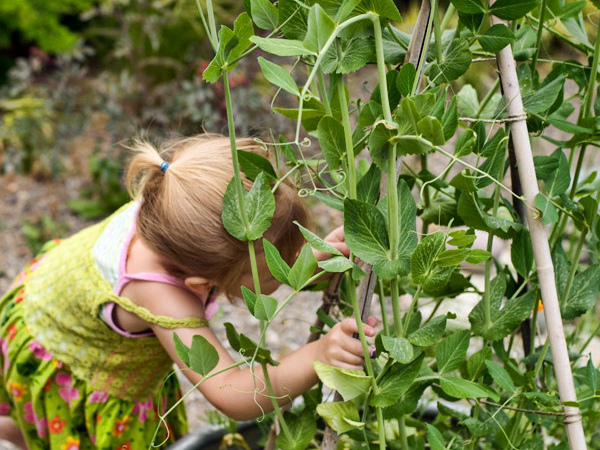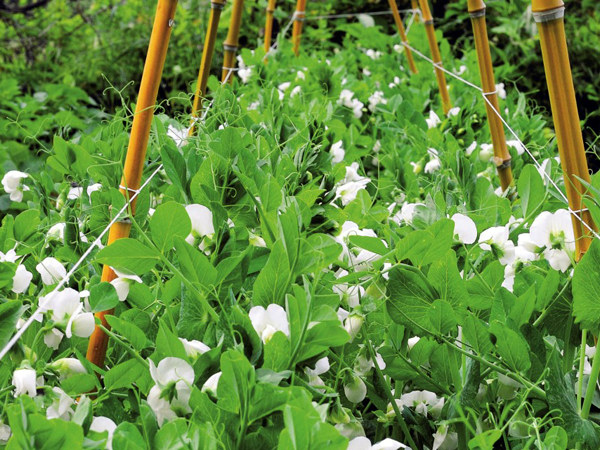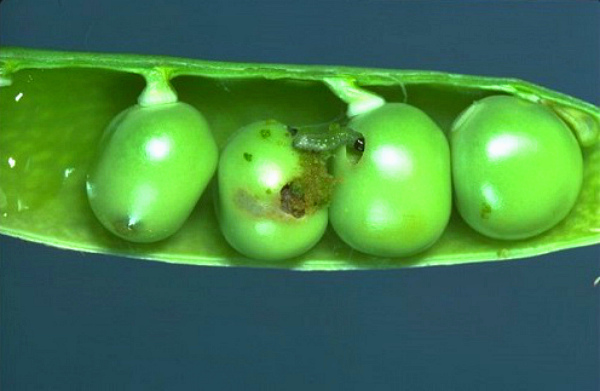King Peas: what does he love and what does not?
Content
Biological features
Peas are an annual climbing crop of the legume family. It has long (up to 2.5 m) herbaceous stems with several petioles, on which feathery leaves are located, ending in branched antennae. With the help of these antennae, the plant twists along the support and is held in an upright position.
Peas are self-pollinating plants. Its peduncles are formed in the axils of the leaves 2-3 pieces and represent a white or slightly purple corolla with a small groove at the bottom, from which a bivalve pod then grows. Inside the bean there are up to 10 grains - spherical or slightly flattened peas.
The root system of the plant is pivotal with highly branched shoots that penetrate deep into the soil. In the upper part of the roots, numerous small tubers develop, containing beneficial microorganisms: nitrogenous, nodule and other types of bacteria. Due to this property, peas, like all beans, contributes to the enrichment of the soil with useful substances, especially nitrogen, which is in a form available to plants.
An interesting fact: according to calculations, one hundred square meters of land allocated for peas, during its cultivation, is enriched with nitrogen by about 1.5 kg, which is equivalent to the introduction of 300 kg of manure into this soil.
According to the shape of the bush, peas are divided into regular (creeping) and standard peas. The latter differs in that its peduncles form small inflorescences of 4-7 flowers closer to the top of the shoots, and the stem itself is thickened, strong with small internodes. As a rule, these varieties are characterized by an early ripening period. Their flowering begins about 30 days after sowing, and flower stalks are formed in the axils of 6-9 leaves (in late-ripening varieties, buds are formed on 12-20 leaves).
There are two types of legumes: grain peas and vegetables. The grain is characterized by smooth, large, easily boiled grains, and it is harvested only after the final ripening. Vegetable, in turn, is subdivided into sugar and shelling. Peeling has a dense parchment layer in the pod. Sugar varieties do not have such a layer, so their grains can be eaten along with the pods. As for the taste, the grains of the shelling varieties are more tender and sweet - they are used for preservation and eaten fresh.
Positive and negative factors
The cultivation of this type of legume, in general, is not particularly difficult. If you create suitable conditions for the culture, then it will delight you with a bountiful harvest. But even in the absence of conditions, good beans can be grown.
Peas are unpretentious plants:
- It is cold-resistant - its seeds are among the first to be sown at the beginning of May, when the soil temperature reaches 5–8 ° C, and the seedlings easily endure the spring morning frosts.
- The plant is an ideal green manure due to its ability to accumulate nitrogen compounds in tubers and enrich the soil with them.
- The culture has no special requirements for the soil - it can grow in any soil except sandy and heavy clay.
- Planting seeds is carried out directly into the ground, which eliminates the need to grow seedlings.
- Peas do not need nitrogen fertilizers, since they themselves accumulate this element in their tubers and transform it into compounds available to plants.
Like any vegetable crop, peas are a little capricious:
- He does not tolerate fresh fertilizers - top dressing should be applied in the fall, and best of all, a year before planting the seeds (under the predecessor).
- You cannot apply fertilizers in the year of sowing seeds or directly during planting - the plant will go into the tops, and flowers and ovaries are not formed.
- You should not plant a culture for two years in the same garden bed - you can return it to its original place only after 4 years.
- The predecessors of peas can be tuberous vegetables, cabbage, pumpkin, cucumbers, but by no means legumes.
- The culture loves the sun - for the garden you should choose open areas where the sun shines intensely for more than half the day.
- If you plant the plants in the shade, then you may not wait for the harvest at all, or there will be very little of it. During the flowering period, the bushes especially need warmth and sun. If at this time a shadow falls on them, the shoots will become long and weak, and flower stalks will not form.
- For a mild sweetish taste, the culture needs to be fed with potash and phosphorus fertilizers, organic matter here will only harm (after the introduction of manure, this type of legume can be planted no earlier than in the second year).
It must be remembered that the yield of peas directly depends on the growing conditions and proper care.
Video "Growing sweet peas"
This video is about how to grow delicious peas in the country. You will learn the intricacies of choosing varieties and planting dates, get advice on growing peas by seedlings.
Pest control
Since pea shoots appear very early, the plant often becomes a bait for pests.
One of his worst enemies is the pea moth, it is also called the weevil. This is an insect that hibernates in the ground and forms cocoons there, from which butterflies fly out when warming. The period of emergence of these butterflies coincides with the flowering of peas, which is a particular threat to the culture.
Butterflies lay their larvae (and sometimes there are at least 200) on flowers, stems and leaves of plants. After a few days, the larvae turn into small caterpillars, which easily crawl into inflorescences, ovaries and stay there until peas are formed. Then they eat the entire contents of the pod, and they no longer have to rely on the harvest.
Gardeners fight the moth by spraying the bushes with infusion of garlic or tomato tops. To get a garlic infusion, you need to chop 20-30 g of garlic, pour 10 liters of the species and leave for 24 hours. Then the infusion is filtered and used for spraying. To prepare tomato infusion, you need to pour 3 kg of tomato tops with 10 liters of water, and also insist for a day. The same infusions are effective against a pest such as aphids.
Often, pea plantings are exposed to powdery mildew. To combat this scourge, you can spray the bed with sow thistle infusion - this is a field weed that is often used as an organic fertilizer or as a remedy for pests. Sow thistle infusion is prepared similarly to garlic and tomato: 300 g of grass (better than leaves) is poured with a bucket of water and infused for 24 hours. The bushes are sprayed once a week. As a rule, after the second spraying, the plants return to their previous state.
Birds inflict no less damage to the pea planting. Since peas are sown very early, their grains become a real delicacy for them. Birds constantly fly to the garden and monitor the crops. As soon as they find at least one grain, they will begin to search and peck out the rest. Some birds, for example, jackdaws peck out even young shoots.Therefore, the garden bed must be covered with dry branches or a special netting, which prevents birds from accessing the ground.
Care
Pea maintenance is not a big hassle. All that he needs at the initial stage is the shelter of seedlings, timely weeding and watering, and later - regular harvesting.
As already mentioned, after sowing the seeds, the garden bed must be hidden from birds. To do this, you can use any available materials: dry branches, a piece of metal mesh, a simple fishing net.
Watering is carried out in different modes. Before flowering, the garden is watered no more than 1 time per week, and then taking into account the weather. During flowering, you need to ensure that the soil is always moist and not allowed to dry out. During this period, watering should be intensive: approximately 10 l / 1 sq. meter.
Watering can be combined with top dressing: add 1 tbsp to 10 liters of water intended for irrigation. spoon of nitroammophoska. After watering, the soil must be loosened. It can also be mulched, which eliminates the need for frequent loosening.
When the beans grow to a height of 15–20 cm, they must be hilled. This procedure helps to increase the resistance of the bushes - they will not fall. Around the same time, you need to install a support, otherwise the plants will intertwine with each other, form a shadow, which will affect flowering and the amount of harvest. If there is no rain, the shoots can be periodically sprayed with water - this will prolong the flowering period, and, accordingly, increase the yield.
The harvesting period is quite extended, and takes on average 1–1.5 months. Early varieties bloom 30 days after sowing, and about a week later, young grains grow, which are especially tasty. From this moment on, you need to collect the beans every 1-2 days, since they appear very quickly.
If the purpose of growing a crop is not green beans, but ripe ones, then you need to leave the pods on the bush until they are fully ripe, wait until they turn yellow and dry. After that, the bushes are cut at the root, collected in bunches and suspended for final ripening.
Video "Pyramid for peas"
This video will introduce you to the idea of constructing a pyramid as a support for peas.







